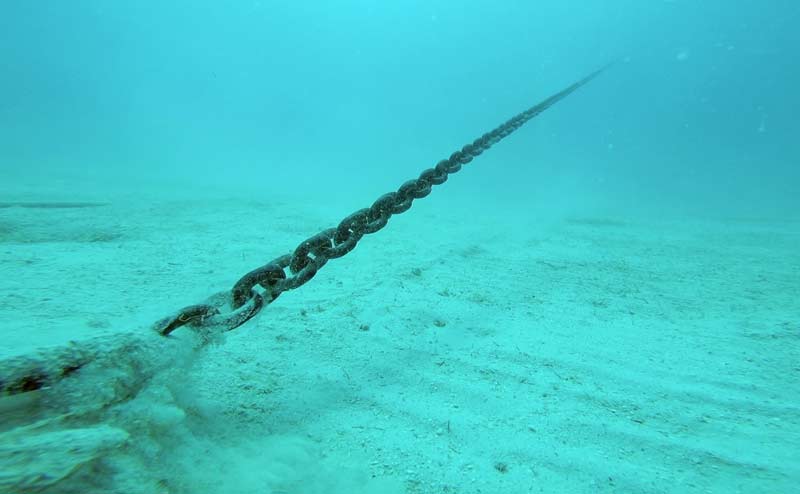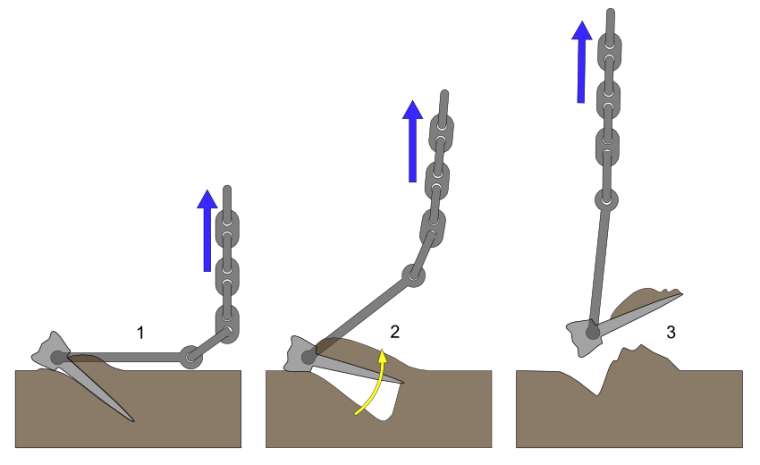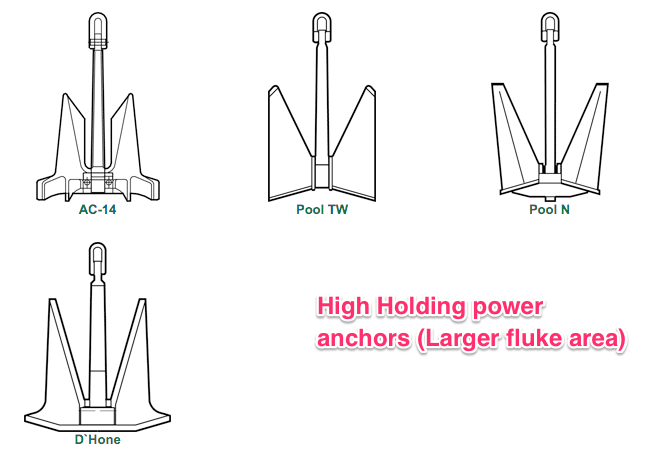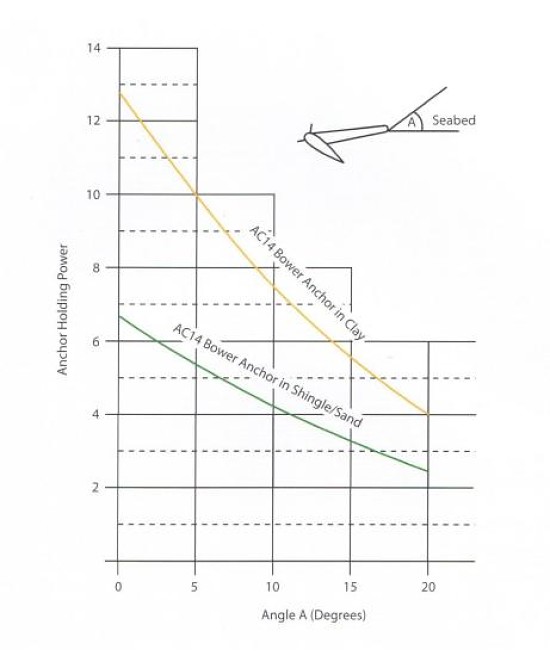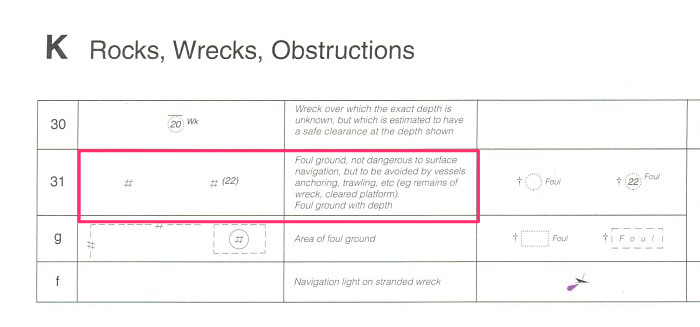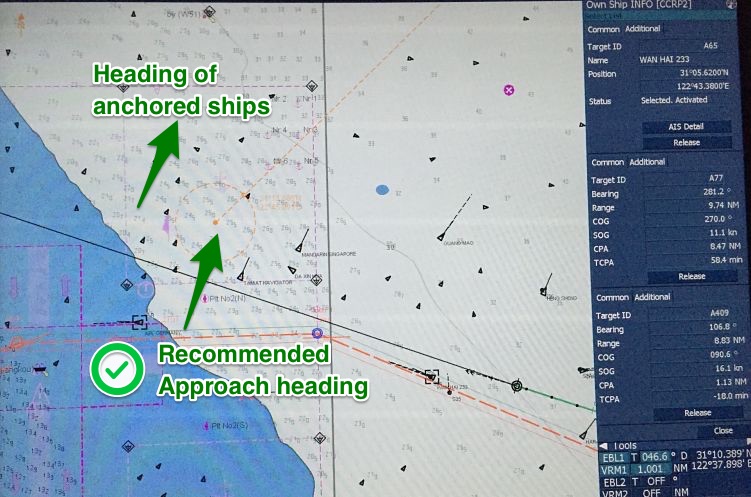Written by Capt Rajeev Jassal on February 13, 2016
Anchoring is as frequent operation on board as loading and unloading a cargo.But in spite of being a frequent operation, the number of incidents related to anchoring never seem to reduce.That is when many minor incidents never come to light to a wider audience.The truth is that even after being a routine operation, effective way of anchoring is not a child’s play.Sure one can just somehow arrive at anchoring position and open the brake to anchor a ship. I am sure you would agree that it is not an effective way of anchoring. Don’t you think so?In this post, let us discuss a practical way of anchoring.But before we do that, we need to discuss two things. First how an anchor holds the ship. And second what guarantees more holding power of anchor.
1. How an anchor holds the ship
When an anchor is dropped, The crown of the anchor is the first to hit the sea bottom. As the ship moves back, the flukes take its position and embed itself into the seabed.
It does not matter from what height the anchor is dropped, the crown will alway hit the bottom first. The flukes will only dig into the seabed once the ship moves aft and flukes are facing downwards into the sea bottom.
As the ship moves back, the fluke takes its position and embed itself into the seabed.
The opposite happens when we pick up the anchor. When the chain is all picked up, the flukes face upwards and gets uprooted from the bottom.
2. Holding Power of anchors
All other factors being common, there are three things that affect holding power of anchors. First is the construction of anchor, second nature of seabed and third the scope of the cable.
Holding power due to anchor construction
A ship’s Equipment number decides the weight of the anchor and length of the chain.
The fluke area determines the holding power of the anchor. International Association of Classification Societies (IACS) governs the rules for anchors.
IACS enlist three types of anchors.
- Normal holding power anchors,
- high holding power anchors
- Super high holding power anchors.
Because of the high and super high holding powers, these anchors can have a lesser weight than the normal anchors. This is because the high holding design (Larger fluke area) compensate for the loss of holding power due to lesser weight.
This is because the high holding design (Larger fluke area) compensate for the loss of holding power due to lesser weight.
Even though anchor weight has nothing to do with holding power per se, it contributes to some extent in holding a ship in its position.
More weight of the anchor would need more force to push the ship from its position. For this reason, anchor weight is more often used as a function of holding power.
Holding power due to nature of Seabed
Another factor that affects the holding power of the anchors is nature of seabed.
Sand is considered to be the strongest holding ground. Soft mud is the least holding ground. This is because of obvious reasons.
Anchor embedded into soft mud would leave the bottom easily compared to the more harder surface like sand. Mariners must consider nature of seabed to determine the possibility of dragging of the anchor.
Holding power due to scope of the anchor cable
The correct scope is essential for safe anchoring and better holding of the anchor. The scope is the ratio of the depth of the water to the length of the cable deployed.
More the scope, better an anchor will hold the ship. The idea of having more scope is that the angle of chain with respect to sea bottom should be minimum.
More the angle, lesser the holding power. OCIMF has published a graphical relation between this angle and holding power of anchor.
As a thumb rule, Scope of 6 is advisable for anchoring. That is when anchoring into a depth of 20 meters, we should pay at least 120 meters of cable. When anchoring in areas of strong wind or current, we should have a scope of more than 6, up to 10 sometimes.
There are two situations where the scope of 6 or more may not be always possible.
- In congested anchorages like in Singapore and
- in deep water anchorages like Fujairah.
In congested anchorages, this is due to insufficient sea room and In deep water anchorage due to insufficient cable length. In calm weather, the lesser scope in these areas should not be a problem.
But if you expect wind force to increase, increased possibility of anchor dragging should be part of the risk assessment.
Now that we have discussed few of aspects of anchoring, Let’sLets anchor a ship.
3. Preparing for Anchoring
Preparing the vessel for anchoring can start days before arrival. This is when a Master checks the charts for marked anchorage areas days before arrival.
Anchorage area for the vessel could also be suggested in the agent’s pre-arrival message. In any case, the Anchorage area must be physically checked in the chart to ensure that
- it is designated for the type of ship,
- the depths complies with the UKC requirement of the company
- depths are less than the maximum depth ship can anchor
- is clear of any cables, pipeline, wrecks or other obstructions. and
- the nature of seabed is appropriate for anchoring
When checking the charts for underwater obstructions, attention should be paid to the chart symbol ‘#’.
This symbol means there is a foul ground and shall be avoided for anchoring. I am particularly mentioning this chart symbol because you may not miss a wreck but it is easier to miss this.
It is important to be aware of the ship’s windlass lifting capacity. In any case, most of the ship’s windlass are able to lift the weight of the anchor and about 3 shackles.
Vessels could easily anchor in depths of about 80 meters. If anchoring in depths more than that, you might need to first check the windlass capacity for the particular ship.
4. Anchor stations
Anchor stations should be ready forward well in advance. The anchor party should make the inspection of the anchor windlass.
They should also ensure that the drive (Hydraulic power packs or electric power) is running. The lashing of both the anchors should be removed even if it is pre-decided about which anchor will be used.
It is a good practice to brief anchor party well in advance of some information about anchoring such as
- the depth of water at the anchoring position
- Which anchor to use
- Anchoring method (Let go or walk back)
- the number of shackles the vessel will be brought up to.
5. Approaching the anchorage position
The most critical factor while approaching anchoring position is the speed of the vessel. Engines must be ready and tested well in advance and the speed of the vessel should be under control.
If Master feels the ship’s speed is much more than what it should be, he should exercise zig-zag maneuver to reduce the speed.
Zig-zag maneuver (also called rudder cycling) is the most effective way to reduce the ship’s speed over a shorter distance. While doing rudder cycling,
While doing rudder cycling, the master must give due consideration to the nearby ships and not run over other ships in the vicinity.
Apart from speed, the direction from which to approach the anchoring position is important. The best approach heading is of heading into the wind and tide. The heading of similar sized anchored vessels can give
The best approach heading is of heading into the wind and tide. The heading of similar sized anchored vessels can give a quite accurate sense of the approach heading. If the traffic density, water
If the traffic density, water depth, and sea room permits, it is better to bring the vessel to this heading at least 1 mile from the anchoring position.
Once on this heading, engine movements should ensure that vessel’s speed is less than 2 knots about half a mile from the anchoring position.
These are just referencing but useful figures. You should consider vessel’s maneuvering characteristics, such as stopping distances to amend these figures. Once the vessel is around
Once the vessel is around half a mile from the anchoring position, we can give stern movement. This is to ensure that vessel is completely stopped at the anchoring position and there is no headway in the forward direction.
During Stern movement, the vessel would cant to starboard side (for right hand fixed pitch propellers).
If we are using the port anchor, this is good as this would ensure the cable is clear of the vessel and will not lead across the bow.
But if starboard anchor is used, there is a chance of anchor chain going under the bow or crossing the bow. In this case, before we give stern movement, vessel’s rudder is put to hard port to get some port swing.
The stern movement would check the port swing and the cable going under the bow can be avoided.
Make sure to bring the rudder to midship during Stern movement. Apart from lateral swing, stern movement of the vessel itself ensures that the cable is clear of vessel’s hull.
However, in all cases, we must ensure that movement of the vessel does not put excessive strain on the windlass. We will discuss this in the next section.
6. Anchoring Methods
As we know, there are two ways an anchor can be dropped to the seabed.
- By letting go
- by walking back.
Each of these ways has its advantages. And in most of the cases, it is up to the discretion of master how he wants to anchor.
But there are certain conditions in which there are no options but to choose a particular method.
Letting go an anchor
Would you agree that anchoring by letting go is easier of the two methods? It is the most used method of anchoring too.
In this method, we open the windlass brake to let the anchor go under gravity.
Before opening the brake, we must consider the height from which we plan to drop the anchor.
If we don’t, we may damage the anchor. Depending upon the height, the damage may not be visible in the same operation but will be visible in the longer run.
There is another obvious risk of dropping the anchor from a height. The anchor under its weight will continue to gain momentum until it touches bottom. This momentum will increase
The anchor under its weight will continue to gain momentum until it touches bottom. This momentum will increase
More the height, more momentum the anchor will gain. This momentum may increase to a point where windlass break would not be able to hold it.
The anchor’s momentum will only stop when the anchor along with entire chain is in the bottom after it has been uprooted from the bitter end.
Watch this.https://www.youtube.com/embed/qZieWR53z2I
What is the referencing height then?
As a thumb rule, you should never allow the anchor to drop from a height of 20 meters. That is, one must lower anchor to a level when the distance between the bottom and the anchor is not more than 20 meters.
But that is a maximum figure. One must lower the anchor to as close to the bottom as possible before it is let go.
But if you aim for lowering the anchor to say one meter above the seabed, you may end up touching the anchor to seabed while the ship still has some speed.
That is not good.
So here is another rule of thumb. We should aim for lowering the anchor to around half shackle from the bottom before we let go.
To summarize, here is how we should anchor the ship by letting go
- Approach the anchor position heading into wind and tide with speed around 2 knots at 0.5NM from the position.
- Lower the anchor with gear to around half shackle off the bottom and then hold the anchor on brake
- Give Stern movement to stop the vessel over the ground once the vessel is in the anchoring position. if using starboard anchor, check the starboard swing (for Right hand fixed pitch propellers) because of Stern movement.
- When in position, drop the anchor by opening the brake
- maintain around 0.5 knots stern speed to allow the cable not to pile up.
- Hold the break once required cable length is paid out.
Anchoring by walking back
Walking back means lowering the anchor with gear.
The principle difference between walk back and let go methods is that in the walk back we lower the anchor under power.
The advantage of this method is that cable would not run on its own. So there is no risk of damaging the anchor or windlass by dropping from a height.
But there is another risk involved with this method. I earlier said that in the “let go” method we should maintain around 0.5 knots astern speed while we are paying the anchor chain.
But even if we exceed this speed to 1.0 knots, only the anchor will pay off. There will not be any load on the windlass. Even when the brake is on, and the chain stresses, windlass brake will be the first thing to render.
But that is not the case with walk back method. In walk back method, since we are lowering the anchor with windlass in gear, excessive speed would surely damage the windlass.
We must not exceed the stern speed to more than the design speed of the windlass.
Typically the design speed of windlass is 9 meters/minute. That is 540 meters/hour (0.3 knots). So we must not exceed the stern speed to more than 0.3 knots while walking back the anchor.
7. Anchor brought up
Once we have lowered the required anchor length, and we have disengaged the gear (in the case of the walk back), we then wait for the anchor to be brought up.
The anchor is brought up when it leads to the long stay and then gradually comes back to short to medium stay.
Once brought up, there is an important thing that we need to do. Put the bar (Bow stopper) on and rest the anchor chain on it.
This is because the load generated by the vessel’s movement during its stay at anchor should be borne by the bow stopper which has higher capacity than the windlass system.
There is a disadvantage though. In heavy weather, there are chances that stopper may jam or deform. In this case, if for some reason vessel needs to let go the cable in the emergency, it would be difficult.
The only solution to it is that the Master must get underway before putting any component of anchoring at the risk of damage. Most of the companies have instructions to the masters to leave the anchorage if wind force is more than force 6. There have been
Most of the companies have instructions to the masters to leave the anchorage if wind force is more than force 6. There have been
There have been incidents of total constructive loss due to master’s decision to stay at Anchorage in spite of adverse weather warnings.
Conclusion
Anchoring is a routine job. Number of incidents during anchoring or while at anchor suggest that we might not have yet mastered the art of anchoring a ship effectively.
Knowing the correct anchoring procedures and their limitations are one of the best ways to avoid anchoring related fatalities and damages.

